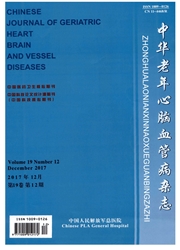

 中文摘要:
中文摘要:
目的探讨前循环同侧短暂性脑缺血发作(TIA)对后续脑梗死的影响及可能机制。方法选取113例前循环脑梗死患者,分为单纯脑梗死组87例和进展脑梗死组26例,分别比较2组早期神经功能恶化(END)、美国国立卫生研究院卒中量表(NIHSS)评分、3个月改良Rankin量表(mRS)评分、脑梗死体积、高敏C反应蛋白(hs-CRP)及其他相关危险因素。结果与单纯脑梗死组比较,进展脑梗死组发生END比例(11.5%vs 31.0%)、出院NIHSS评分[(1.85±2.31)分vs(3.30±3.65)分]、3个月mRS评分[(0.90±0.83)分vs(1.78±1.77)分、hs-CRP[(2.52±3.23)mg/L vs(6.21±32.23)mg/L]、脑梗死体积[(3.92±8.05)cm3 vs(9.15±15.07)cm3均明显减小(P〈0.05);脑梗死前7~14dTIA发生2~3次、TIA持续时间〉10min的患者上述指标的变化最为显著;hs-CRP与END(r=0.311,P=0.014)、入院NIHSS评分(r=0.455,P=0.000)及脑梗死体积呈正相关(r=0.524,P=0.000)。结论 TIA对后续脑梗死具有缺血预处理作用,其作用可能与hs-CRP水平下降有关。
 英文摘要:
英文摘要:
Objective To study the effect of anterior circulation transient ischemic attack(TIA)on ipsilateral ischemic stroke and its mechanism.Methods One hundred and thirteen patients with anterior circulation ischemic stroke were divided into simple ischemic stroke group(n=87)and progressive ischemic stroke group(n=26).Their END,NIHSS score,3-month mRS score,infarct size,serum hs-CRP level and other risk factors were compared.Results The incidence of END,NIHSS score at discharge,3-month mRS score and serum hs-CRP level were significantly lower whereas the infarct size was significantly smaller in simple ischemic stroke group than in progressive ischemic stroke group(11.5%vs 31.0%,1.85±2.31 vs 3.30±3.65,0.90±0.83 vs 1.78±1.77,2.52±3.23mg/L vs 6.21±32.23mg/L,3.92±8.05cm3 vs 9.15±15.07cm3,P〈0.05).TIA occurred 2-3times on days 7-14 befor ischemic stroke and lasted 〉10min showed lower incidence of END,lower NIHSS score and 3-month mRS score,and lower serum hs-CRP level.The serum Hs-CRP level was positively related with the NIHSS score and infarct size(P=0.000).Conclusion TIA plays a role in ischemic preconditioning of ipsilateral ischemic stroke by decreasing the serum hs-CRP level.
 同期刊论文项目
同期刊论文项目
 同项目期刊论文
同项目期刊论文
 期刊信息
期刊信息
